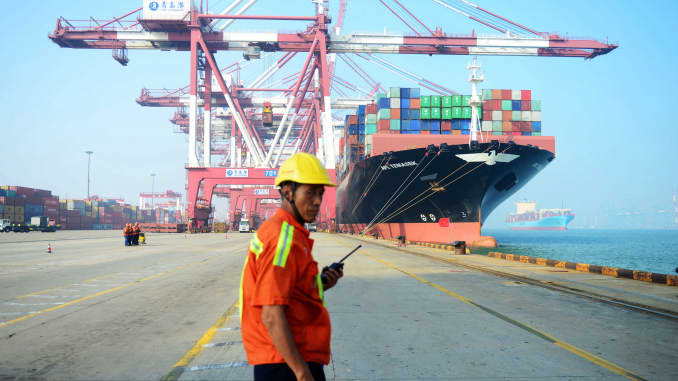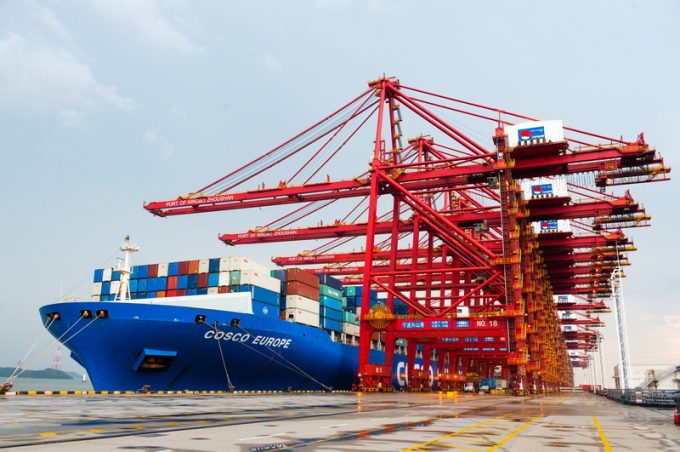Post-COVID China Monopolizing Global Food Shipping Containers
 |
A Chinese worker looks on as a cargo ship is loaded at a port in Qingdao, eastern China’s Shandong province. AFP Contributor | AFP | Getty Images |
"People aren't getting their goods where they need them.""One of my customers ships eight to ten containers of rice every week from Thailand to Los Angeles. But he can only ship two to three containers a week right now.""It's been like that since December. You're going to get not only a shortage of food but a shortage of everything.""I would not be surprised to hear some beneficial cargo owners' freight rates for 2021-2022 shipping seasons double from previous years."Steve Kranig, director of logistics, IMEX Global Inc. freight forwarder"It's not possible to get the amount of volume we have here in Vancouver to return containers in those tight windows.""Pulses [crops such as peas and lentils] in general are struggling getting on the ships."Jordan Atksins, vice-president, WTC Group"We know that some of the industry's largest and most consistent buyers of soybean containers in Asia over the years are now electing to buy bulk vessel supplies.""And certainly like others, we had some booking cancellations.""It's a bit of a perfect storm. You have pent up demand in Asia for agriculture products and that's at the same time you have a pretty substantial consumer goods demand in the U.S.""When you add to that some of these labour issues, that's what really created the scarcity you are seeing."Doug Grennan, vice-president, select global grain and oilseeds, Scoular Co.
 |
The Global Food Trade Has Been Upended by a Container Crisis Bloomberg |
China is well ahead of the rest of the world in its initial recovery from COVID-19, accelerating its export economy and in the process willing to pay out huge premiums for containers. A situation that has made it quite a bit more profitable to have the containers returned empty, rather than normally refilling them on return. This has led to soaring freight rates increasing the cost of some foods. As an example, white sugar prices surged last month to a three-year high while delays in food-grade soybean shipments from the U.S. may anticipate higher costs for consumers of tofu and soy milk in Asia.
 |
Carriers are now content to continue hauling shipping containers empty to China, the profit motive initialling that on the dotted line. Competition for the steel containers has resulted in Thailand unable to ship its rice, Canada stuck with peas, and India unable to offload mountains of sugar. While shipping empty boxes back to China as a profitable new enterprise has created backlogs and shortages where even some U.S. soybean shippers have had to fight for containers so anxious Asian buyers can be supplied.
Carriers usually make an effort to backfill shipping containers to maximize profit from shipping rates in both directions. The cost of carrying goods from China to thr U.S. comes in at close to ten times higher than the reverse journey, persuading liners to gain profit in favouring empty boxes rather than loading them, according to data. Three in every four boxes going back to Asia from the port of Los Angeles, the biggest for container cargo in the U.S., now travel empty, in comparison to the normal 50 percent rate.
 |
Canada, the second-largest producer of pulses in the world, is experiencing difficulty in meeting the new time limits to transport stuffed boxes at terminals onto ships, from three days to as little as seven hours. India was able to export only 70,000 metric tonnes of sugar, as the world's second-largest producer in January representing less than a fifth of the volume shipped last year. The largest producer of robusta coffee beans used to make instant drinks and espresso, Vietnam now struggles to export.
Worldwide, foodstuff buyers cool their heels, while others have taken to halting purchases altogether. It is now conceivable that once the bulk of North American and European vaccinations have been completed and life returns to normal these high freight rates may be passed to these populations returning to cafes, restaurants and office towers, as a rude awakening of the fall-out still being experienced as a consequence of the turmoil caused by the SARS-CoV-2 pandemic.
 |
| Photo 130984715 © Hunterbliss - Dreamstime.com |
China's vast demands on American crops meant to provide feedstock for a hog herd recovering from a deadly pig disease has come along faster than anticipated, making for a dire situation leading some buyers to cancel contracts choosing instead bulk shipping methods, commonly used for feed products, or in an effort to avoid high freight costs, delaying purchases. Yet, given the economic slowdown caused by the coronavirus, it remains unclear how much of the increase in shipping costs companies may plan to pass on to consumers.
Refrigerated containers have also been impacted by the pandemic where in China, boxes have been piled up at ports while workers must comply with strict COVID-testing procedures as well as disinfection of meat and seafood products in the wake of China claiming that frozen food imports were responsible for the spread of the coronavirus. The volume of cold containers in the port of Dalian is such that there are insufficient power plugs for them.
And then there is the issue of labour shortages as a result of the coronavirus spread slowing operations at ports and deleteriously impacting the container shortage. Demand for American agriculture products has been boosted by strikes in Argentina, affecting supplies to Asia, further increasing competition for boxes.
 |
Labels: China Exports, Complications, Container Shortages, Global Pandemic, Shipping

0 Comments:
Post a Comment
<< Home